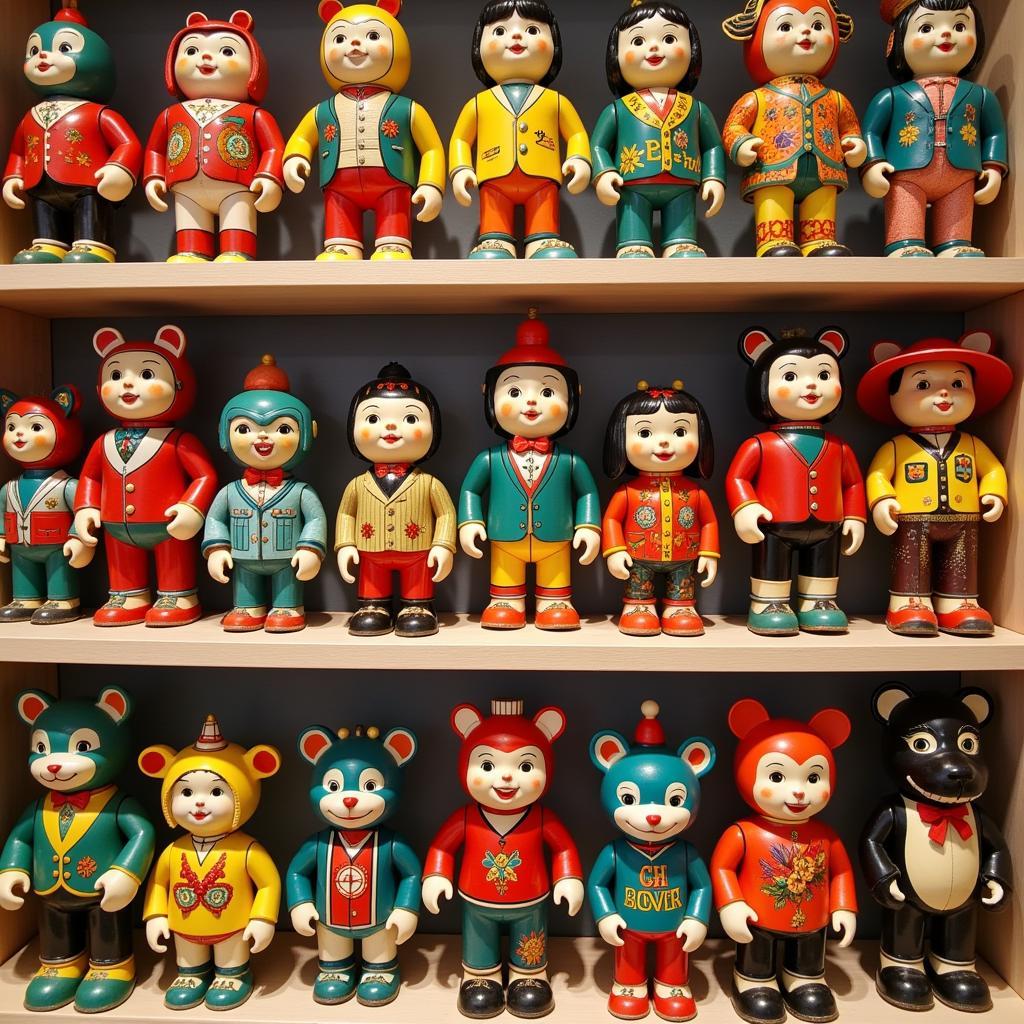Tin In Japanese, often referred to as “ブリキ” (buriki), holds a special place in the hearts of many. This seemingly simple material has been intricately woven into the tapestry of Japanese culture, evolving from its practical origins to become a symbol of nostalgia, craftsmanship, and artistic expression.
 Vintage Japanese tin toys on display
Vintage Japanese tin toys on display
From Humble Beginnings to Beloved Icons: The History of Tin in Japanese Culture
The journey of tin in Japanese culture began in the late 19th century, during the Meiji Restoration. As Japan opened its doors to the world, Western influences began to permeate various aspects of society, including manufacturing. Tinplate, a thin sheet of steel coated with tin, emerged as a versatile and affordable material, quickly finding its way into everyday life.
Early applications of tin in Japan were primarily utilitarian. From simple containers and household items to signage and packaging, tin’s durability and resistance to corrosion made it a practical choice. However, it wasn’t long before Japanese artisans recognized the artistic potential of this humble material.
The Golden Age of Japanese Tin Toys: A Testament to Ingenuity and Playfulness
The post-World War II era witnessed the rise of Japanese tin toys, capturing the imagination of children and adults alike. Skilled craftsmen, drawing inspiration from both traditional Japanese motifs and Western trends, transformed tinplate into an astonishing array of toys.
From wind-up robots and airplanes to miniature cars and whimsical characters, these toys were more than just playthings; they were miniature works of art. The vibrant colors, intricate details, and ingenious mechanisms reflected the dedication and skill of Japanese artisans.
Beyond Toys: The Enduring Appeal of Tin in Japanese Art and Design
While Japanese tin toys remain highly collectible items today, the use of tin in Japanese art and design extends far beyond the realm of playthings.
-
Traditional Crafts: Tin is incorporated into traditional Japanese crafts, such as “Kyuudo” (Japanese archery) equipment and tea ceremony utensils. Its malleability and ability to hold intricate designs make it a valued material for creating both functional and decorative pieces.
-
Contemporary Art: Contemporary Japanese artists continue to explore the creative possibilities of tin. From sculptures and installations to jewelry and mixed media pieces, tin’s unique texture and reflective qualities offer a distinctive aesthetic.
-
Interior Design: Tin panels, tiles, and accents are finding their way into modern Japanese interiors, adding a touch of industrial chic and vintage charm. These elements can be used to create statement walls, backsplashes, and decorative accents.
Preserving a Legacy: The Future of Tin in Japanese Culture
In an age of mass production and digital entertainment, the enduring appeal of tin in Japanese culture speaks volumes about its intrinsic value. The tactile nature of the material, the intricate craftsmanship involved, and the nostalgic memories it evokes continue to resonate with people across generations.
While the heyday of mass-produced Japanese tin toys may be in the past, the legacy of tin in Japanese culture lives on. Contemporary artisans and designers continue to push the boundaries of this versatile material, ensuring that its story continues to be written for years to come.
FAQ: Frequently Asked Questions about Tin in Japanese Culture
1. What makes Japanese tin toys so special?
Japanese tin toys are renowned for their exceptional craftsmanship, intricate details, imaginative designs, and vibrant colors. They represent a unique blend of traditional Japanese aesthetics and Western influences, making them highly collectible items today.
2. Where can I find authentic Japanese tin toys?
Authentic Japanese tin toys can be found at antique shops, vintage toy stores, online marketplaces specializing in collectibles, and auctions. It’s important to research and buy from reputable sellers to ensure authenticity.
3. Is tin still used in contemporary Japanese art and design?
Yes, tin continues to be a source of inspiration for contemporary Japanese artists and designers. It is incorporated into sculptures, installations, jewelry, mixed media pieces, and even interior design elements, adding a touch of industrial chic and vintage charm.
4. What are some traditional Japanese crafts that utilize tin?
Tin is used in traditional Japanese crafts like “Kyuudo” (Japanese archery) for crafting parts of the bow and arrows. It’s also found in tea ceremony utensils, where its malleability and ability to hold intricate designs are highly valued.
5. Why is tin still relevant in a modern, digital world?
Tin’s enduring appeal lies in its tactile nature, the intricate craftsmanship it allows, and the nostalgic memories it evokes. In a world dominated by mass production and digital experiences, the uniqueness and artistry of tin offer a refreshing contrast.
Exploring Further: Delve Deeper into the World of Japanese Tin
For those intrigued by the allure of “tin in Japanese” and eager to explore further, we invite you to discover the fascinating world of japanese tin toys. These intricately crafted pieces offer a glimpse into a bygone era and showcase the remarkable craftsmanship that continues to captivate collectors and enthusiasts worldwide.
Need Assistance? We’re Here to Help!
If you have any questions or need further information, please don’t hesitate to contact us.
- Phone: 0372998888
- Email: [email protected]
- Address: 30 Hoàng Cầu, Hà Nội
Our dedicated customer support team is available 24/7 to assist you.